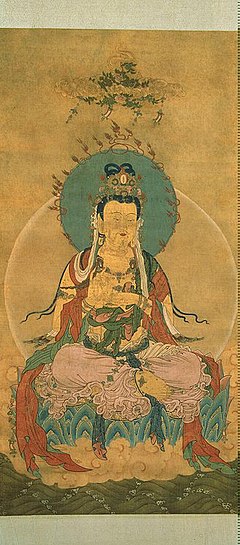Mahasthamaprapta
| Mahāsthāmaprāpta | |
|---|---|
 | |
| Sanskrit | महास्थामप्राप्त
Mahāsthāmaprāpta |
| Chinese | (Traditional) 大勢至菩薩 or 得大勢菩薩 (Simplified) 大势至菩萨 or 得大势菩萨 (Pinyin: Dàshìzhì Púsa or Dédàshì Púsà) |
| Japanese | 大勢至菩薩 (romaji: Daiseishi Bosatsu) |
| Khmer | មហាស្ថាមប្រាប្ត (mo-haa-sthaam-praap) |
| Korean | 대세지 보살
(RR: Daeseji Bosal) |
| Thai | พระมหาสถามปราปต์โพธิสัตว์ |
| Tibetan | མཐུ་ཆེན་ཐོབ Wylie: mthu chen thob THL: Tuchen tob |
| Vietnamese | Đại Thế Chí Bồ tát |
| Information | |
| Venerated by | Mahāyāna, Vajrayāna |
| Attributes | Wisdom, Power |
Mahāsthāmaprāpta is a bodhisattva mahāsattva that represents the power of wisdom, often depicted in a trinity with Amitābha and Avalokiteśvara (Guanyin), especially in Pure Land Buddhism. His name literally means "arrival of the great strength".
Mahāsthāmaprāpta is one of the Eight Great Bodhisattvas in Mahayana Buddhism, along with Mañjuśrī, Samantabhadra, Avalokiteśvara, Ākāśagarbha, Kṣitigarbha, Maitreya and Sarvanivarana-Vishkambhin.
In Chinese Buddhism, he is usually portrayed as a woman[1], with a likeness similar to Avalokiteśvara. He is also one of the Japanese Thirteen Buddhas in Shingon Buddhism. In Tibetan Buddhism, Mahāsthāmaprāpta is equated with Vajrapani, who is one of his incarnations and was known as the Protector of Gautama Buddha.
Mahāsthāmaprāpta is one of the oldest bodhisattvas and is regarded as powerful, especially in the Pure Land school, where he takes an important role in the Longer Sukhāvatīvyūha Sūtra.
In the Śūraṅgama Sūtra, Mahāsthāmaprāpta tells of how he gained enlightenment through the practice of nianfo, or continuous pure mindfulness of Amitābha, to obtain samādhi. In the Amitayurdhyana Sutra, Mahāsthāmaprāpta is symbolized by the moon while Avalokiteśvara is represented by the sun.[2]
China
Yìnguāng (Chinese: 印光), a teacher of Pure Land Buddhism, was widely considered to be a manifestation of Mahāsthāmaprāpta based on the accounts of two people:
1. Huìchāo (Chinese: 慧超), a former Christian who had never heard of him before
2. Běnkōng (Chinese: 本空), a Buddhist monk and former student
Both of these figures had independent dreams regarding the situation.[3][4][5]
Japan
In Japan, Mahāsthāmaprāpta (Japanese: 勢至 Seishi) is associated with the temple guardians Kongō Rikishi.[6]
He is recognized as one of the Thirteen Buddhas.
Mantra
(Sanskrit):
Namaḥ samantabuddhānāṃ, jaṃ jaṃ saḥ svāhā
(Homage to all Buddhas! Jaṃ jaṃ saḥ! svāhā)[7]
(Japanese):
(Shingon) on san zan saku sowaka (オン・サン・ザン・サク・ソワカ)
(Tendai) on sanzen zensaku sowaka (オン・サンゼン・ゼンサク・ソワカ)
References
- ^ http://www.chinabuddhismencyclopedia.com/en/index.php/Mahasthamaprapta_(Shih_Chih,_Seishi)
- ^ http://www.chinabuddhismencyclopedia.com/en/index.php/Mahasthamaprapta_(Shih_Chih,_Seishi)
- ^ 净土的见证(一) Archived 2015-01-04 at the Wayback Machine
- ^ 共尊印光大师势至化身原因一_新浪佛学_新浪网
- ^ 印祖的故事-海天佛国奇缘
- ^ Josephine Baroni, Helen. The Illustrated Encyclopedia of Zen Buddhism. p. 240.
- ^ The Vairocanābhisaṃbodhi Sūtra (PDF). BDK America, Inc. 2005.
Bibliography
- Getty, Alice (1914). The gods of northern Buddhism, their history, iconography, and progressive evolution through the northern Buddhist countries, Oxford: The Clarendon press, p.100.

